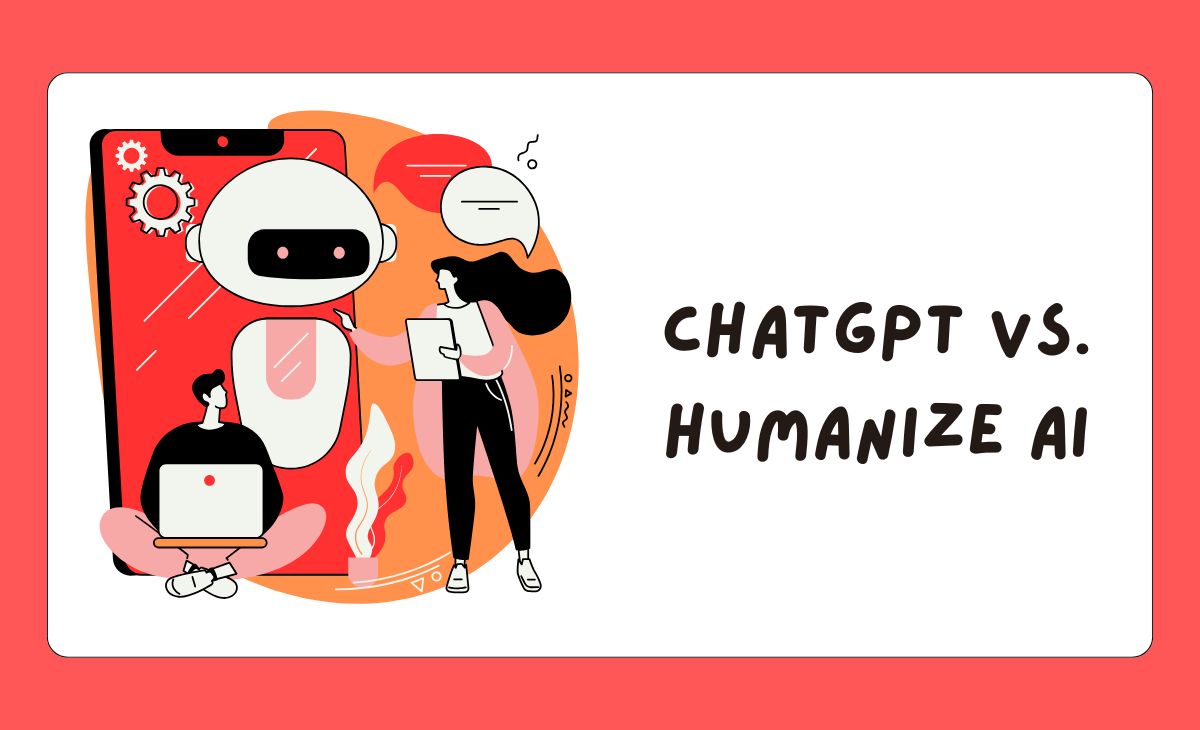There is a sudden rise in AI content writers, where every other AI tool promises to deliver the perfect piece. However, as of now, there is only one tool that crafts pieces next to perfection, and that’s ChatGPT.
Its evolution has been nothing short of impressive. ChatGPT can differentiate between content formats, modulate its tone, and produce immaculate writing. But the real question here is something else. It is the persistent discomfort of relying on a tool that is not trained to accommodate individual creativity.
We live in a time where people are hungry for something new, bold, and fresh out of the oven. This often puts ChatGPT on the radar: are its pre-trained datasets equipped enough to tell an innovative story that's not been told yet?
This is exactly where Humanize AI comes into the picture. Its advanced algorithms give your writing the creative flair that it needs. Whether you’re writing a blog by yourself or generating your essay through ChatGPT, Humanize AI is the one that maintains your authentic voice from being subdued.
But, the real question here is if we had to rely on only one setup and had to forgo the other, which one should it be? Read along to find out as we bridge this gap and dive into some finer details.
ChatGPT: The Pioneer of AI Conversations
OpenAI made history with ChatGPT, which made artificial intelligence not only accessible but also a household name. It operates on a conversational model and can be used for various purposes, including writing. As we see more AI tools making a mark in the present market, ChatGPT has always been the guiding light.
It is one of those AI content tools that is an advanced AI language model and is designed to understand and generate human-like texts. ChatGPT operates on a prompt basis, where you talk to the AI and help curate the narrative.
Strengths:
Using ChatGPT is not only about its swiftness, but also about its efficiency and the lack of AI hallucinations to help put the point across.
✅ Versatility: ChatGPT is capable of writing any form of content that you want. Be it blogs, articles, captions for your Instagram, or even a LinkedIn post, it can do it all. All you have to do is write what you want, and that’s it.
✅ Conversational Nature: Relying on ChatGPT has reached a point where people are now using it for their therapy sessions too. As in, the tool is capable of understanding the nuances of your prompt and allows it modifications.
Here is a quick example :
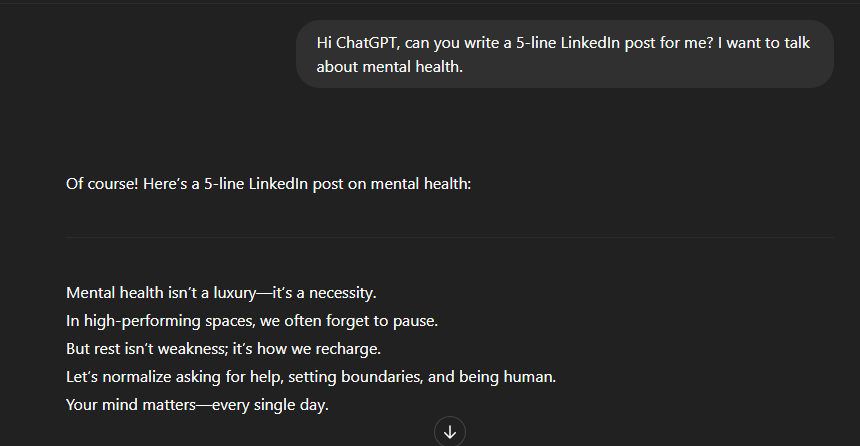
ChatGPT sample generation
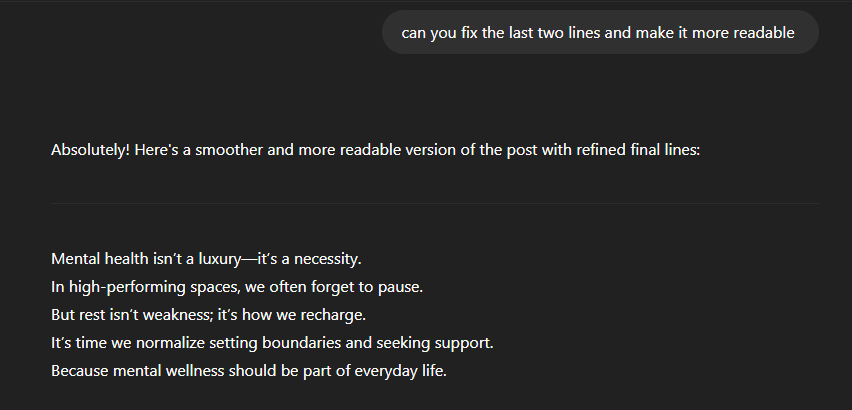
ChatGPT prompt refinement
➡️ You will notice that you can talk to the AI to make it understand the context and the type of content you want. If you take this particular chat, you can direct it to convert the entire conversation into a blog in the next prompt itself.
✅ Fast Output: One thing you must know about this AI writing assistant is that ChatGPT is fast. It can generate a 2000-word blog in seconds, that too without losing the plot. In fact, it is now capable of generating pictures to aid you further in the process.
Limitations:
Can AI write like a human is one of the most talked about questions of our decade. The reason behind it is simple: using ChatGPT feels like a blessing from an efficiency point of view. But, it lacks massively on the creative aspect.
❌ Robotic Tone: Reading ChatGPT-generated content usually feels like an instruction manual rather than a two-way conversation. You will never find it addressing the reader at any given point, nor talking about user-specific concerns. Now, imagine establishing a connection with your future audience on the basis of such content.
❌ Generic Outputs: ChatGPT is a robotic setup that is trained to follow your prompt, and that’s it. It doesn't have the capacity to understand the blood and soul you put into your brand, which reflects in its writing. Moreover, its training data compels it to generate the same type of content for both you and your competitor.
❌ Lack of brand tone awareness: If we look at the present market situation, repurposing the same old content is next to self-sabotaging. You cash in on your brand’s voice rather than your product’s capability.
➡️ If you are selling an AI writing tool, your brand tone should focus on how it can help fight the creative block or make research easier. If you keep asserting ChatGPT’s tone that it's a “highly optimized product “and offer no relevant context, you will lose out on the deal.
Humanize AI: Built for Brand-Specific Content
Humanize AI helps convert AI-generated content into personalized pieces. It is like giving a robotic text the much-needed makeover and making it sound human. Even though it doesn’t have a conversational setup, it is capable enough to set the right tone for your writing. If you are constantly worried by the thought of how to make AI content sound more human, well, it's your one-stop shop.
Strengths:
You need a setup like Humanize AI because it is practically impossible to handpick every AI-generated blog and refine it manually. It helps to tie all the loose ends and makes your content refined for the set Google standards.
✅Emotional Quotient: A robotic tone is one of the first giveaways of AI-generated writing. Not only does it fail to form a connection with your users, but disrupts your SEO strategies. This is why Humanized AI is equipped to add the right amount of emotions to make it sound natural. It knows when to be empathetic and when to sprinkle humor for the right effect.
✅Brand-aligned tone: You don’t have to redirect Humanize AI to the ways to refine your content. The moment you paste the required text, it knows the pitfalls in it and how to make it less tone-deaf for better connectivity.
✅All content formats: Humanize AI knows only one thing, and that’s making your content sound more human. So, regardless of a blog, article, or LinkedIn post, it will do its job with utmost efficiency.
You will notice that it doesn’t overcomplicate the narrative but adds subtle changes in the required places to make it more human. Here is a quick example of how it refined the previous ChatGPT-generated prompt.
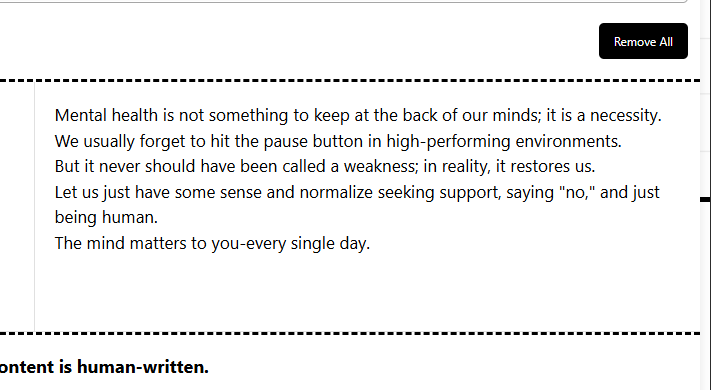
Humanize AI-generated results
Key Differences Between ChatGPT and Humanize AI
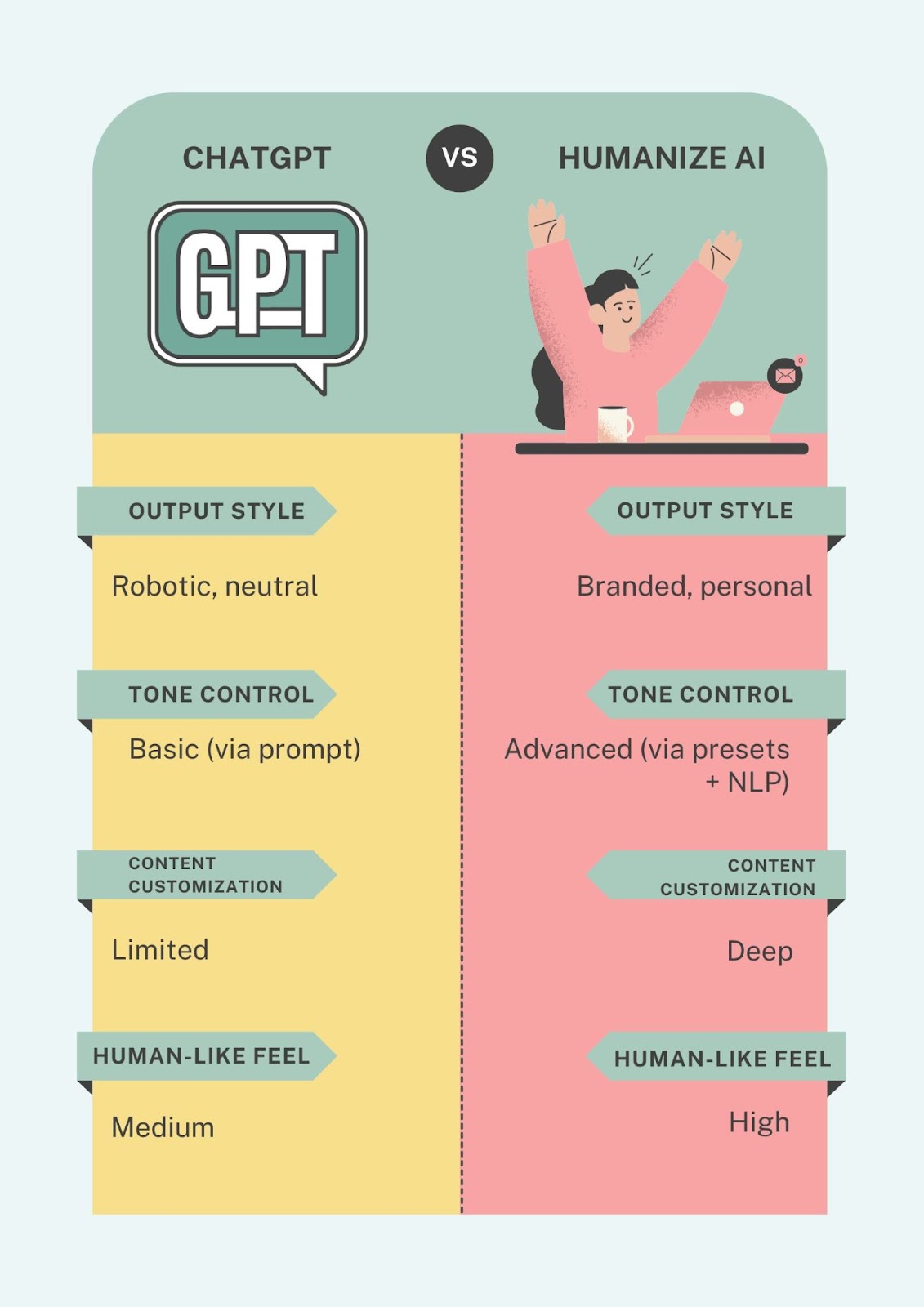
SEO & Engagement: Who Wins?
It’s critical to understand the SEO implications before deciding on a tool that’s going to work for you. No matter how great your content is, it needs to rank and get you conversions. Using a tool to establish a better personal connection is important because it gives a trust signal to the search engines. This is where Humanize AI has better control of the situation.
🚨As you get to curate the flow of your brand from scratch and weave a narrative that feels relevant, natural, and relatable, you get an upper hand. With better retention and improved scroll depth, you can expect improved conversion rates.
On the other hand, ChatGPT can help you with scalability. If you wish to generate a large volume of content, be it blogs, LinkedIn, social media, or product descriptions, ChatGPT can do it for you in seconds. However, you have to sacrifice personalization and scope to connect with your readers.
Quick Tip 💡: Google’s E-E-A-T guidelines (Experience, Expertise, Authoritativeness, Trustworthiness) always favor content that's authentically human. So, relying on generic content generation can be a huge risk.
Which One To Choose, ChatGPT or Humanize AI?
Deciding a winner between these two tools is always tricky, as they are not supposed to be pitted against each other. They are two separate building blocks in your content generation process.
You can most definitely run your content setup with ChatGPT and generate as many pieces of work as you can. But you won’t be able to sustain your entire setup, as machine-generated content at the end of the day is a futile attempt.
ChatGPT-generated content will :
- Have SEO repercussions
- Fail to connect with the audience
- Bring a fresh perspective
- Sustain your brand image
But what if I tell you get to keep ChatGPT’s speed and mass produce content that has a humanized tone.
Humanize AI doesn’t have any restrictions as it refines your content. All it knows is to add that human touch and make it readable. If you are wondering who does a better job at humanizing your content, it’s always going to be a setup like Humanize AI.
It’s not about a situation where you pitch the tools against each other, but have a sustainable setup that offers a viable solution for you to keep generating valuable content.
Conclusion
What might seem like a cut-throat competition can be an ideal content setup for you if you are looking for scalability backed by personalization. With ChatGPT, you have efficiency, speed, and volume.
On the other hand, with Humanize AI, you can add a personal touch to your content. It gives you the platform to be more relatable, connect on a wider level, and build that personal connection. It helps you tell a story that is bound to resonate with your audience.
So, this isn’t really a ChatGPT vs. Humanize AI debate. It’s about building a sustainable content system. It's about ChatGPT handling the quantity, and Humanize AI ensures the soul in the race for numbers.
FAQs
Does using Humanize AI change the voice of ChatGPT-generated content?
Yes, Humanize AI is designed to rewrite and enhance the robotic tone of ChatGPT. It is the whole point of using a tool like Humanize AI, as it takes your content and gives it a personal touch. It is known to reflect your brand’s unique tone and help you have a better connection with your readers.
Is it ethical to use Humanize AI for humanizing ChatGPT-generated content?
Using any AI tool is ethical as long as you are transparent and using it the right way; there is nothing that can cause an ethical dilemma. A tool like Humanize AI doesn’t make things up or twist the truth. All it does is help you write in a way that resonates with your brand and from a better connection with your audience.

